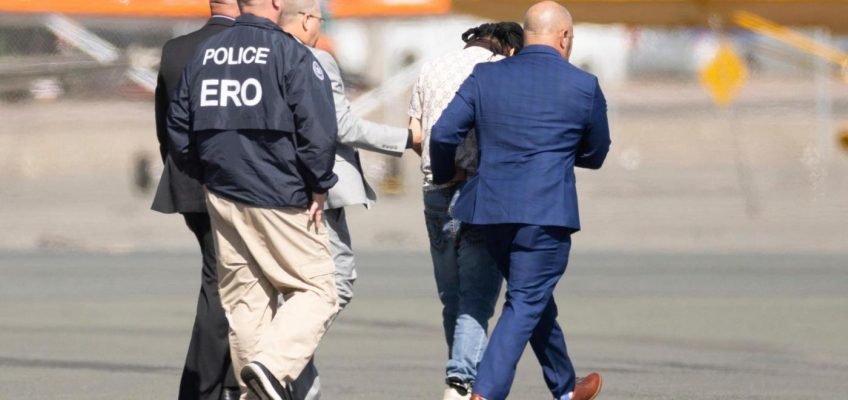By WYATTE GRANTHAM-PHILIPS and PAUL WISEMAN, AP Business Writers
President Donald Trump says he will slap a 100% tax on movies made outside the United States — a vague directive aimed at protecting a business that America already dominates.
Related Articles
Dar Global to launch a $1 billion project in Saudi Arabia in a deal with Trump Organization
What we know about Trump’s peace proposal for Gaza
Trump’s big bill is prompting urgent action in some Democratic states, but not in Republican ones
Airspace violations force NATO to tread a tightrope, deterring Russia without hiking tensions
Trump and Netanyahu meet at the White House as pressure mounts to end the war in Gaza
Claiming that movie production “has been stolen’’ from Hollywood and the U.S., Trump posted on his Truth Social platform that “I will be imposing a 100% tariff on any and all movies that are made outside of the United States.’’
It was unclear how these tariffs would operate, since movies and TV shows can be transmitted digitally without going through ports. Also unclear is what it would mean for U.S. movies filmed on foreign locations — think James Bond and Jason Bourne — or what legal basis the president would claim for imposing the tariffs.
The president had first issued the threat back in May. He has yet to specify when the tariff might go into effect.
Movies are an odd battleground for a U.S. trade war. “Unlike any other country’s film industry, U.S. movies are the most accessible, well-known, and best performing due to the numerous language options and worldwide reach provided by U.S.-based studios,” trade analyst Jacob Jensen of the center-right American Action Forum wrote in a July commentary.
In movie theaters, American-produced movies overwhelmingly dominate the domestic marketplace. Data from the Motion Picture Association also shows that American films made $22.6 billion in exports and $15.3 billion in trade surplus in 2023 — with a recent report noting that these films “generated a positive balance of trade in every major market in the world” for the U.S.
Barry Appleton, co-director of the Center for International Law at the New York Law Center, warned that other countries may retaliate with levies on American movies or other services. In movies, “Brand America is way, way ahead,’’ he said. “What this policy does is actually cook the golden goose that’s laying the golden eggs.’’
Tariffs are Trump’s go-to solution for America’s economic problems, a tool he likes to use to extract concessions from other countries. Reversing decades of U.S. support for lower trade barriers, he’s slapped double-digit tariffs on imports from almost every country on earth. And he’s targeted specific products, including most recently pharmaceuticals, heavy trucks, kitchen cabinets and bathroom vanities.
Unlike other sectors that have recently been targeted by tariffs, movies go beyond physical goods, bringing larger intellectual property ramifications into question.
Here’s what we know.
Why is Trump threatening this steep movie tariff?
Trump has cited national security concerns, a justification he’s similarly used to impose import taxes on certain countries and a range of sector-specific goods.
In May, Trump claimed that the American movie industry is “DYING to a very fast death” as other countries offer “all sorts of incentives” to draw filmmaking away from the U.S.
In recent years, U.S. film and television production has been hampered between setbacks from the COVID-19 pandemic, the Hollywood guild strikes of 2023 and the recent wildfires in the Los Angeles area. Incentive programs have also long-influenced where movies are shot both abroad and within the U.S., with more production leaving California to states like Georgia and New Mexico — as well as countries like Canada.
At the same time, international markets make up a large chunk of Hollywood’s total box office revenue — accounting for over 70% last year, according Heeyon Kim, an assistant professor of strategy at Cornell University. She warned that tariffs and potential retaliation from other countries impacting this industry could result in billions of dollars in lost earnings and thousands of jobs.
“To me, (this) makes just no sense,” Kim previously told The Associated Press, adding that such tariffs could “undermine otherwise a thriving part of the U.S. economy.”
The International Alliance of Theatrical Stage Employees, which represents behind-the-scenes entertainment workers across the U.S. and Canada, said in May that Trump had “correctly recognized” the “urgent threat from international competition” that the American film and television industry faces today. But the union said it instead recommended the administration implement a federal production tax incentive and other provisions to “level the playing field” while not harming the industry overall.
How could a tax on foreign-made movies work?
That’s anyone’s guess.
“Traditional tariffs apply to physical imports crossing borders, but film production primarily involves digital services — shooting, editing and post-production work that happens electronically,” Ann Koppuzha, a lawyer and business law lecturer at Santa Clara University’s Leavey School of Business, explained when Trump first made his May threat.
Koppuzha added that film production is more like an applied service that can be taxed, not tariffed. But taxes require Congressional approval, which could be a challenge even with a Republican majority.
Making a movie is also an incredibly complex — and international — process. It’s common for both large and small films to include production in the U.S. and in other countries, or overseas altogether. Steven Schiffman, a longtime industry veteran and adjunct professor at Georgetown University, pointed to popular titles filmed outside the U.S. — such as Warner Bros’ “Harry Potter” series, which was almost entirely shot in the U.K.
U.S. studios shoot abroad because tax incentives can aid production costs. But a blanket tariff across the board could discourage that or limit options — hurting both Hollywood films and the global industry that helps create them.
“When you make these sort of blanket rules, you’re missing some of the nuance of how production works,” Schiffman said previously. “Sometimes you just need to go to the location, because frankly it’s way too expensive just to try to create in a soundstage”
Could movie tariffs have repercussions on other intellectual property?
Overall, experts warn that the prospect of tariffing foreign-made movies ventures into uncharted waters.
“There’s simply no precedent,” Koppuzha said in May. And while the Trump administration could extend similar threats to other forms of intellectual property, like music, “they’d encounter the same practical hurdles.”
But if successful, some also warn of potential retaliation. Kim pointed to “quotas” that some countries have had to help boost their domestic films by ensuring they get a portion of theater screens, for example.
Many have reduced or suspended such quotas over the years in the name of open trade — but if the U.S. places a sweeping tariff on all foreign-made films, these kinds of quotas could come back, “which would hurt Hollywood film or any of the U.S.-made intellectual property,” Kim said.
And while U.S. dominance in film means “there are fewer substitutes” for retaliation, Schiffman noted that other forms of entertainment — like game development — could see related impacts down the road.




